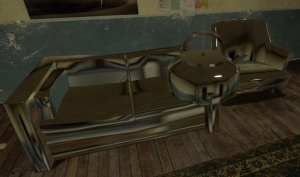$envmap: Difference between revisions
Jump to navigation
Jump to search
TomEdwards (talk | contribs) (untrue, you're doing something wrong) |
(→Syntax) |
||
| Line 10: | Line 10: | ||
"env_cubemap" is normally used, as it tells [[VBSP]] to swap in the name of the nearest [[env_cubemap]] when the map compiles. However it is also possible to enter the name of a texture directly. | "env_cubemap" is normally used, as it tells [[VBSP]] to swap in the name of the nearest [[env_cubemap]] when the map compiles. However it is also possible to enter the name of a texture directly. | ||
: {{TODO|Document how to create a custom cube map for use. For now, the process can be found below.}} | |||
http://www.facepunch.com/showthread.php?p=23320997 | |||
== Additional Parameters == | == Additional Parameters == | ||
Revision as of 18:29, 25 July 2010
The $envmap VMT parameter creates specular reflections, which are seen on smooth surfaces. It does this by defining an "environment map" (specifically a cubemap) to draw as a reflection; normally that of the nearest env_cubemap entity. The reflection is not dynamic.
The other form of reflection supported by Source is the diffuse phong type.
Syntax
$envmap env_cubemap
"env_cubemap" is normally used, as it tells VBSP to swap in the name of the nearest env_cubemap when the map compiles. However it is also possible to enter the name of a texture directly.
- Todo: Document how to create a custom cube map for use. For now, the process can be found below.
http://www.facepunch.com/showthread.php?p=23320997
Additional Parameters
$envmapmask <texture>- See
$envmapmask. A VTF file that determines per-texel reflection intensity. $envmaptint "[<red float> <green float> <blue float>]"- Controls the intensity of the reflection's red, green and blue color channels. Any positive number can be used. Default is
"[1 1 1]", which means 100% intensity. Note:You must use quotemarks, as there are space characters within the value.
Note:You must use quotemarks, as there are space characters within the value. Tip:This command is often used to dim the brightness of a specular reflection without the overhead of an
Tip:This command is often used to dim the brightness of a specular reflection without the overhead of an $envmapmask. $envmapcontrast <normal>- Controls the contrast of the reflection. 0 is natural contrast, while 1 is the full squaring of the color (i.e. color*color).
 Tip:Use higher contrasts to diminish relatively darker areas and increase "hot spots".
Tip:Use higher contrasts to diminish relatively darker areas and increase "hot spots".$envmapsaturation <normal>- Controls the colour saturation of the reflection. 0 is greyscale, while 1 is natural saturation.
$envmapframe <int>- The frame to start an animated cubemap on.
$envmapmode <int?>- Todo: ?
$basetexturenoenvmap <bool>$basetexture2noenvmap <bool>- Probably used for materials with two albedos, to make one or the other matte. Require DirectX 9; see also
$basetextureand$basetexture2. $envmapoptional <choices>- Sets the oldest DirectX version that should draw the reflection. Choose from:
80(DirectX 8)81(DirectX 8.1)90(DirectX 9)95(DirectX 9 with Shader Model 3)
$envmapsphere Confirm:Switches from cubemap to spheremap mode? Probably deprecated.
Confirm:Switches from cubemap to spheremap mode? Probably deprecated.
Console commands
buildcubemaps- Generates cubemaps for use in materials. If this isn't run, objects will reflect the skybox (OB) or have an invalid, white reflection (Ep1).
r_showenvcubemap <bool>- Debug command to display cubemaps on all dynamic objects at full intensity. It was used to create the image at the start of this article.
See Also
- $envmapmask (specular mask)
- $phong (for diffuse reflection)
- Cubemap
